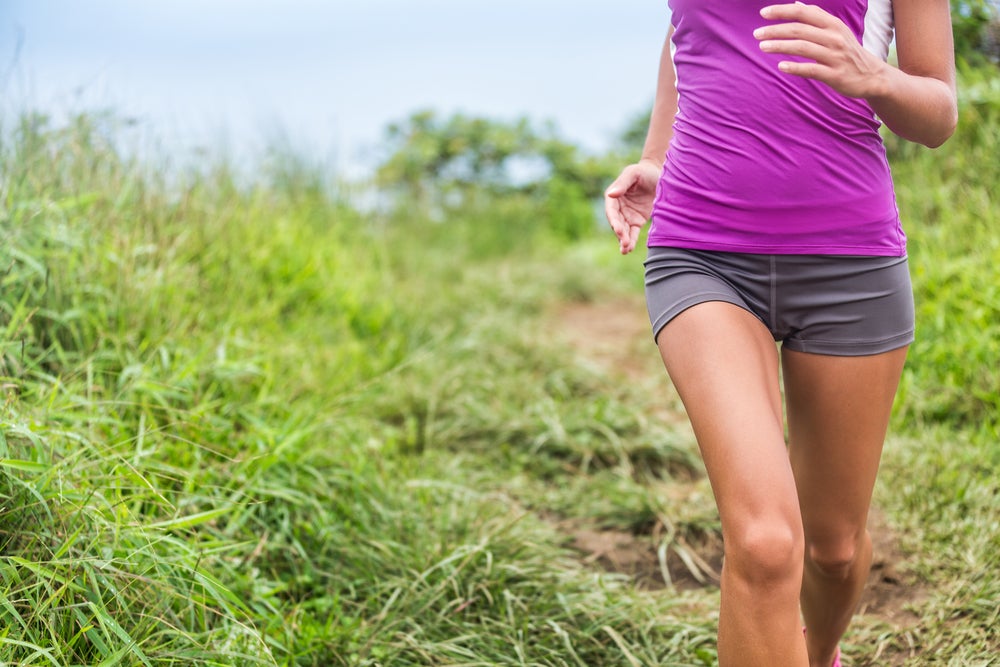Why Runners Should Care About The Gluteus Medius

When a runner thinks of important muscles for performance and avoiding injury, most of the time the hamstrings or calves—or even the trunk musculature—is a prime focus. While those muscle groups are certainly important, there is a little muscle on the side of the hip that may be one of the biggest players in runner health and performance: the gluteus medius.
With attachments below the top (crest) of the pelvic (coxal) bones and the outside of the upper leg (femur), the action of the gluteus medius is to raise the upper leg to the side (hip abduction). However, it is the resistant action (eccentric) of the gluteus medius to not allow the collapse of the knee inward that plays a critical role in the health of the hips, ankles and especially knees.
On the surface, a knee injury would logically be attributed to a problem with the knee. See most doctors and you will probably get some meds to help control inflammation and be told to rest, ice and pull back on the mileage. For most runners, though, chronic knee pain is probably attributable to a continuous failure happening somewhere in the musculature chain each gait cycle. So the question then is, what failed in the muscular chain to cause the knee pain?
Understanding how the body works is best viewed through a joint by joint approach. If you look at the sequence of joints from the ankle to the hip you will see a pattern. The ankle is supposed to be mobile, the knee stable, the hip mobile, the lower back stable, the middle back mobile and so on. Pain developed in the knee then could be a lot of things including patella tracking which could mean a stable joint has become mobile in ways it was not intended. One of the other joints above and below the knee then must have become too stable or too unstable (hypermobile).
The joint above the knee is obviously the hip which should be mobile enough to adequately absorb forces coming from foot strike. However, even though the hip should be mobile it should not be hypermobile. A weak gluteus medius will put the hip in a situation that a mobile joint has become hypermobile. The hip then is not absorbing the bulk of the forces and is instead passing it along to the knee and lower back.
Trendelenburg Gait
One of the common, telltale signs of gluteus medius weakness is Trendelenburg gait. Trendelenburg is simply a condition when one foot is on the ground in the stance phase but the opposite hip with the foot off the ground drops. The hips would be teeter tottering side-to-side during running when viewing the backside of someone with Trendelenburg gait.
The real issue with the hip drop with Trendelenburg gait is the stance leg (the one with the foot on the ground) which will see an inward knee collapse as the opposite hip drops. The inward knee collapse puts a lot of tension on the ACL ligament and can alter how the knee cap tracks between the femur (upper leg) and tibia (lower leg). The resultant failure of the glute medius to control the inward collapse of the knee produces a litany of problems, including the aforementioned patella tracking issues and IT Band Friction Syndrome which produces pain on the outside of the knee.
Training the Gluteus Medius
Hop on YouTube and you will see a bunch of exercises including clams, double clams, jailbirds and lateral shuffling with bands. All those exercises are effective, just be sure to resist the band or gravity when returning the leg to the starting position. Remember that the gluteus medius’ most important function is to resist the inward collapse of the knee so it must be trained accordingly. Many runners rush through the exercises without spending the time to slow down. Work with a 3-4 second cadence when returning the leg back to the starting position when using any gluteus medius exercise.
Chronic nagging injuries, especially in the knee, can probably be traced back to a weak gluteus medius. Try spending four to five days a week rotating two to three exercises (at least one exercise per session) for three sets of eight to ten repetitions. Include the exercises as either a warm up or cool down, a small commitment for a potentially huge return on injury reduction and performance.